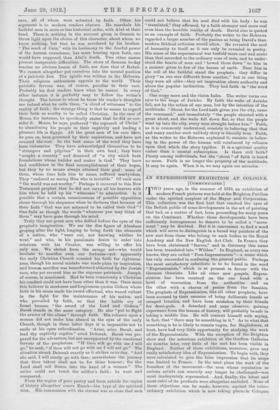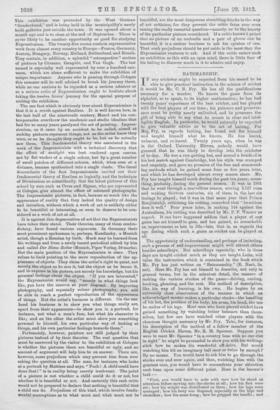AN EXPRESSIONIST EXHIBITION AT COLOGNE. [Commusuokren.]
TWO years ago, in the summer of 1910, an exhibition of modern French pictures was held at the Brighton Pavilion under the spirited auspices of the Mayor and Corporation. This collection was the first hint that reached the eyes of the British public of some developments in the art of painting that had, as a matter of fact, been proceeding for many years on the Continent. Whether these developments have been sufficiently homogeneous to deserve to be called a " move- ment " may be doubted. But it is convenient to find a word which will serve to distinguish in a broad way painters of the new sort from those who belong to such bodies as the Royal Academy and the New English Art Club. In France they have been christened "fauves," and in Germany this name has been translated into " Wilden." In England, as every one knows, they are called "Post-Impressionists "—a name which has only succeeded in confusing the general public. Perhaps the most satisfactory substitute is to he found in the word "Expressionists," which is at present in favour with the German theorists. Like all other new gospels, Expres. sionism has been received on the one baud with a howl of execration from the authorities and on the other with a chorus of praise from the fanatics. The prophets of Expressionism, like all other prophets, have been accused by their enemies of being deliberate frauds or escaped lunatics, and have been mistaken by their friends for demi-gods. A detached and sane observer, gaining experience from the lessons of history, will probably be safe in taking a middle line. He will content himself with saying, in fact, that "there may be something in it." As to what that something is he is likely to remain vague, for Englishmen, at least, have had very little opportunity for studying the work of the Expressionists. With the exception of the Brighton show and the notorious exhibition at the Grafton Galleries six months later, very little of the sort has been visible in England. Neither of these exhibitions, moreover, gave any really satisfactory idea of Expressionism. To begin with, they were calculated to give the false impression that its scope was limited to France. In the next place the work of the founders of the movement—the men whose reputation as serious artists can scarcely any longer be challenged—was most inadequately represented. And, finally, the latest and most &etre of its products were altogether excluded. None of these objections can be made, however, against the extra- ordinary exhibition which is now taking place.. in Cologne. This exhibition was promoted by the West German " Sonderbund," and is being held in the municipality's newly built galleries just outside the town. It was opened about a month ago and is to close at the end of September. There is never likely to be another opportunity so good for studying Expressionism. The twenty-five rooms contain representative work from almost every country in Europe--France, Germany, Austria, Hungary, Norway, Holland, Switzerland, and Russia. They contain, in addition, a splendid "retrospective" section of pictures by Cezanne, Gauguin, and Van Gogh. The last named is especially well represented by over a hundred can- vases, which are alone sufficient to make the exhibition of unique importance. Anyone who is passing through Cologne this summer will be well advised to break his journey there, while no one anxious to be regarded as a serious admirer or as a serious critic of Expressionism ought to hesitate about taking the twelve hours' journey for the special purpose of visiting the exhibition.
The one fact which is obviously true about Expressionism is that it is a revolt against Realism. It is well known how, in the last half of the nineteenth century, Manet and his con- temporaries overthrew the academic and studio idealism that had for so many years paralysed the art of painting. Impres- sionism, as it came by an accident to be called, aimed at making pictures represent things, not as the artist knew they were, or as he thought they ought to be, but as he actually saw them. This fundamental theory was associated in the work of the Impressionists with a technical discovery that the effect of sunlight was best rendered upon canvas, not by flat washes of a' single colour, but by a great number of small patches of different colours, which, when seen at a distance, became synthesized into a single shade. The lineal descendants of the first Impressionists carried out their fundamental theory of Realism BO logically, and the technique of Divisionism so scientifically, that the latest pictures of this school by men such as Cross and Signac, who are represented at Cologne, give almost the effect of coloured photographs. The Impressionist pictures, in fact, became so much like the appearance of reality that they lacked the quality of design and intention, without which a work of art is unlikely either to be beautiful or interesting, or even to deserve to be con- sidered as a work of art at all.
It is against this degeneration of art that the Expressionists have taken their stand. Their theories, many of them contra- dictory, have found various exponents. In Germany their most prominent spokesman is, perhaps, Kandinsky, a Munich artist, though a Russian by birth. Much may be learned from his writings and from a newly issued periodical edited by him and called Der Blanc Boiler (Munich, Piper Verlag, 10 marks).
But the main position of the Expressionists is dear. They refuse to limit painting to the mere reproduction of the ap- pearance of objects. They claim the artist's right to paint, not
merely the object as he sees it, but the object as he knows it,
and to express in his picture, not merely his knowledge, but his personal feelings about the object. "If you are interested,' the Expressionist would say, "merely in what things look like, you have the camera at your disposal. By improving photography, and especially colour photography, you will
be able to reach a perfect reproduction of the appearance
of things. But the artist's business is different. On the one Land his business is to show you what things really are,
apart from their appearance—to show you in a portrait, for instance, not what a man's face, but what his character is like; and on the other the artist must show you something personal to himself, his own particular way of looking at things, and his own particular feelings towards them."
Fortunately, however, painters are still judged by their pictures instead of by their theories. The real question that must be answered by the visitor to the exhibition at Cologne is whether the pictures there are beautiful or ugly, and no amount of argument will help him to an answer. There are, however, some prejudices which may prevent him from ever asking the question at all. The man, for instance, who looks at a portrait by Mattisse and says, " Pooh ! A child could have done that! " is in reality being merely irrelevant. The point
of a picture is not whether a child could do it or not, but whether it is beautiful or not. And certainly this rash critic
would not be prepared to declare that nothing is beautiful that a child can do. Prejudices of this kind, which involve funda- mental assumptions as to what must and what must, not be
beautiful, are the most dangerous stumbling-blocks in the way of art criticism, for they prevent the critic from ever even raising the really essential question—namely, as to the beauty of the particular picture considered. If a critic knows a priori that no picture of an umbrella and a pair of gloves can be beautiful, it is a useless business to ask his opinion of one. That such prejudices should be put aside is the most that the Expressionist ventures to ask. And if the critic enters such an exhibition as this with an open mind, there is little fear of his failing to discover much in it to admire and enjoy.























































 Previous page
Previous page